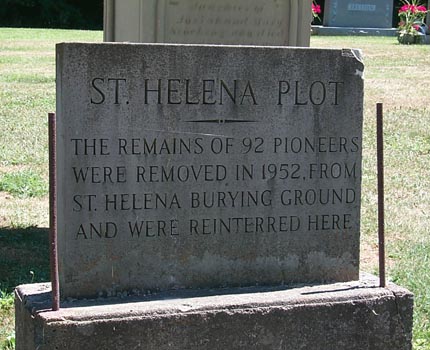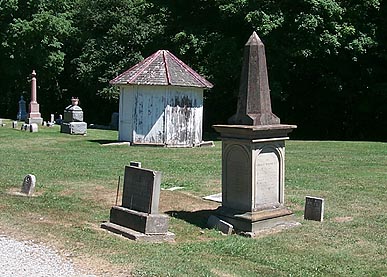Like most communities, the "Ghost Town" of St. Helena once had its own burial ground. Located on the west bank of the Genesee just north of the community, the cemetery was used from the 1840's to perhaps the 1890's.
Long after the last residents left the Valley, the cemetery remained, overgrown and all but forgotten until the 1950's. When the Mt. Morris Dam was completed, it became necessary to move the cemetery out of the Valley.
The State of New York ordered that the bodies be moved. The work fell to a firm from Niagara Falls which carefully exhumed the bodies. Although there were only eight monuments standing in the cemetery, workers found total of ninety-two bodies, many being infants and children. The remains were placed in small wooden boxes measuring 1' X 2' X 2 1/2', made at a local lumber mill.
Among the bodies was one that appeared to be a Native American. Mildred Anderson wrote "there was some speculation as to whether the body could be that of Jesse Jemison, son of Mary Jemison "The White Woman of the Genesee". According to Mary Jemison's life story, her son Jesse was killed in a drunken brawl by his brother John, while engaged in logging operations for Robert Whaley, near Tea Table Rock, at Wolf Creek. Burial was made after the manner of the white people. The fact that this occurred about 1812, while the land at St. Helena was not sold until 1823, would cause some doubt as to the possibility of the remains being those of Jesse Jemison" (Anderson, St Helena, p 45)
The remains and the few markers were reinterred at Castile's Grace Cemetery. The monument shown below marks the special St. Helena plot.

Because so many of the graves were unmarked - their gravestones lost or their simple wooden markers worn away, most of the St. Helena residents who were brought to Castile cannot be identified. Mrs. Anderson did record the names on the remaining stones, which have been listed below:
|
|
Asa W. died Dec. 17, 1845, 86 y 4 m |
|
|
Sally, wife of Richard Emmett, daughter of Josia and Mary Stocking, died Aug 1, 1851, 18y |
|
|
William, died May 12, 1851, 57y 3m 22d. |
|
|
George E., died Oct 4, 1848, 4m. |
|
|
Lydia E., daughter George M. and Lucy, died March 22m 1875, 1y 6m 5d. |
|
|
Helen.daughter Josiah and Mary, died Jan. 29, 1845 6
y |
|
|
John, son S.M. and Mary, died April 10 1846, 10 y 1m. |
As one reads through the names and dates, one begins to sense the difficult life the early settlers of St. Helena faced. The Stocking family, for example, had four children when they came to St. Helena and, according to Mrs. Anderson, four more were born there. During the high water of a January thaw, measles swept through the valley, claiming two of the Stocking children. Because of the flood waters, the story goes, the little coffins had to be strapped to boards and drawn up over the bank opposite Wolf Creek and then later buried at St. Helena cemetery when the waters receded. Little Helen and Dennis were joined by their older sister Sally six years later. Her husband, Richard Emmett, was the local stone cutter and made the largest monument that stood in the burial grounds. (It can be seen just to the right of center in the image below.) (Anderson, p3)

The Stocking children along with nearly ninety others, now sleep several miles from the Valley where they lived and died. But even if they now rest in Castile and not in the old boundaries of the ghost town of St. Helena, they will always be part of the history of Letchworth State Park.
Tom Cook
August 2001
Sources
Anderson, St Helena